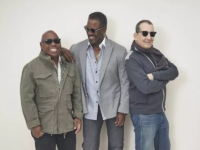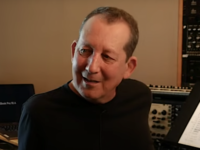A look at five jazz albums with grooves in the pocket — even if they weren’t much in the press. We delve into mainstream figures like Grover Washington Jr. and David Sanborn, a left-turn moment from Jeff Lorber, a capstone moment from the classic Wayne Henderson/Larry Carlton configuration of the Crusaders and, to begin, a groover from Herbie Hancock, appearing with two of his former VSOP cohorts …
HERBIE HANCOCK – MR. HANDS (1980): The 1970s began very creatively for Herbie Hancock, first with the space-funk Mwandishi albums followed by the better-known Headhunters period that firmly established Herbie’s preeminence in synthesized instrumental funk. But as the decade wore on, the music got less and less creative until it devolved into generic disco.
Right at the end of this period, though, Hancock re-asserted control to generate an electric jazz album where every song was distinguishable and original. Jaco Pastorius puts in meaningful contributions on two tracks, while fellow VSOP alums Ron Carter and Tony Williams guest on a nice island-flavored tune appropriately titled “Calypso.”
Harvey Mason’s tricky rhythm on “Shiftless Shuffle” is a reminder of the genius he bestowed on Headhunters seven years earlier. But “Just Around The Corner” has got to rank up there with one of the funkiest tunes ever to come from Hancock, the bass/drum progression is the very definition of funk.
JEFF LORBER – WATER SIGN (1979): Smooth jazz enthusiasts are familiar with the conservatory-trained keyboardist for his consistent offerings within that genre over the last decade. Lorber actually began recording in the mid-1970s and was at the time very much influenced by the fusion giants of the time, such as Return To Forever, George Duke and Hancock.
While he could never be considered an innovator, Lorber was at times a damned good imitator and improvisor, especially early in his career. Thus, Water Sign has the best thumb-popping-bass beats of the time combined with creative compositions and neatly packaged jams. Cameos by jazz heavies like Freddie Hubbard and Joe Farrell didn’t hurt, either.
GROVER WASHINGTON JR. – LIVE AT THE BIJOU (1977): At the height of his pre-Winelight popularity, Washington cuts a live date in his home town of Philly and amply demonstrates that the allure of his sound wasn’t entirely dependent on producer Creed Taylor’s studio magic.
Not a lot of big names playing in his band, but it’s tighter than a drum. Yeah, this too is very much a period record, but it still grooves with a vengeance.
I mean, how can you sit still through songs titled “Funkfoot” and “Lock It In The Pocket”? Oh, and in case you were wondering, he does play his classic “Mister Magic” here, too.
THE CRUSADERS – THE SECOND CRUSADE (1973): The rekindled interest of the funk-jazz of 25-30 years ago has cast a spotlight squarely on one of its best performers: the classic Wayne Henderson/Larry Carlton configuration of the Crusaders. The Second Crusade is perhaps their finest, because at this point their songwriting was strong enough to dispense with the pop covers that was a feature of earlier albums and the weren’t yet too far removed from jazz that they traded in their chops for radio play.
“A Search For Soul” is one of the earliest indications of Joe Sample’s composing prowess, while “Tomorrow Where Are You” manages to pull off a compelling one-chord groove. “Don’t Let It Get You Down” is the vintage Gulf Coast R&B these Houston boys were best at. If you can’t find this one, 1974’s Southern Comfort and 1976’s Those Southern Knights make fine substitutes, too.
DAVID SANBORN – UPFRONT (1992): While no Coltrane or Rollins, David Sanborn must have the most instantly recognizable sax of all … and it’s a sound that fits in just about any setting. It fits best, perhaps, in the soulful kind of R&B music that is the unambiguous mission of this record.
While longtime producer/bassist Marcus Miller helped to craft a heavily synthesized funk sound for Sanborn throughout the prior decade, he puts the altoist/sopranoist in a more organic setting here that doesn’t sound so much of the time, providing us instead with some timeless grooves.
Some decent guitarists on here, too: Hiram Bullock, Cornell Dupree, and this guy named Eric Clapton.
- Ches Smith Quartet – ‘Clone Row’ (2025) - May 30, 2025
- James Brandon Lewis Quartet – ‘Abstraction Is Deliverance’ (2025) - May 27, 2025
- Soft Machine – ‘Drop’ (1971, 2025 remaster) - May 21, 2025





Pingback: Dan Siegel, Marion Meadows, Jeff Lorber and Marc Antoine: Personality and Presence